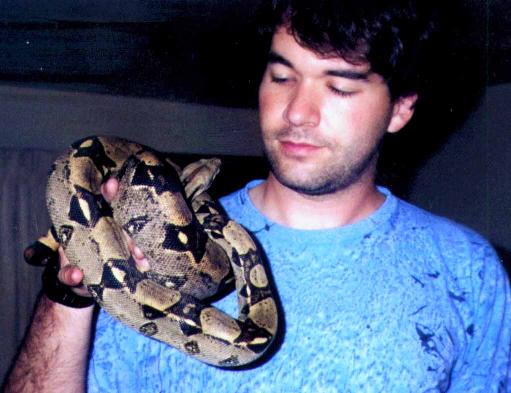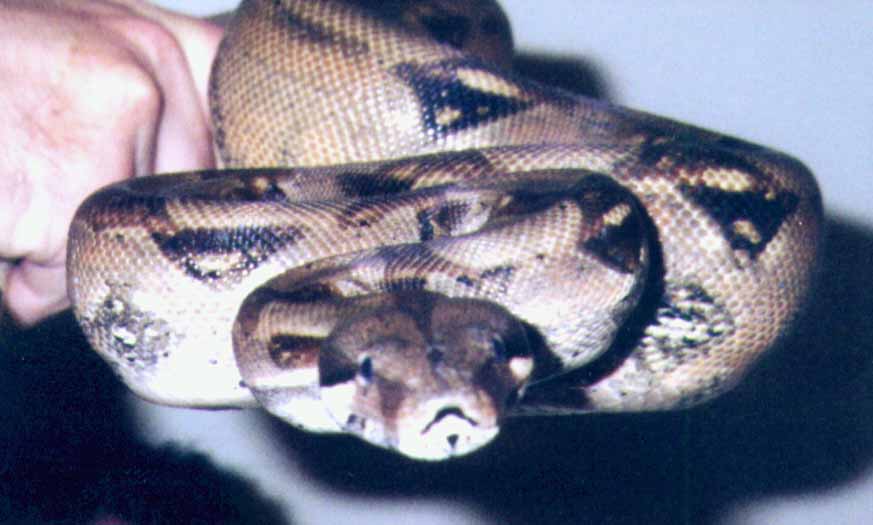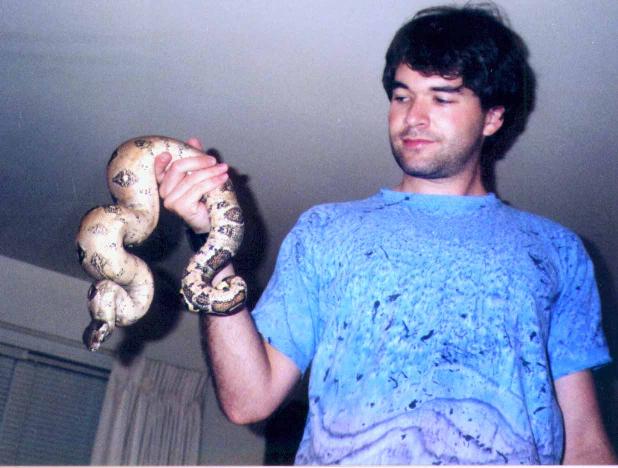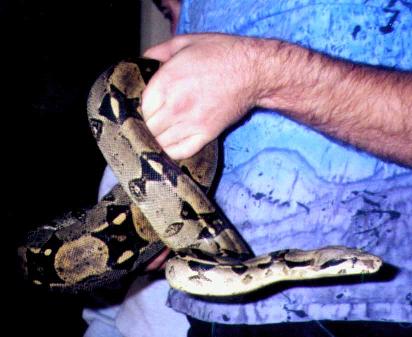

Here are some of my boas. My first boa was named Misha. Misha has had several changes in conceptual gender -- I couldn't figure out if she was male or female. Now I believe that she is female. Misha was first purchased as a baby by some friends of mine from a reptile show in the San Francisco area. They gave her to me when they didn't want her any more. My second boa is named Draco, and was acquired in much the same way, from a fellow student at davis who couldn't take care of him. (Draco is pictured in the photo above). I raised both of them from when they were not more than a quarter grown. A while back, I gave both of them to my friend Eve, who has more of an interest in snakes than I do. However, after about a year, I got them back, along with a third boa, named Brunhilda. (Eve got the prehensile tailed skinks. At this time, it's not really clear who ownes what, but the issue of exact ownership, like boa gender, doesn't seem to be all that important at the moment). Brunhilda is another case of gender confusion, because she is male.
Boas are not much work to take care of. After you get their cage set up properly, you can more or less just feed them once every week or two, clean their cage once every week or two, make sure they have clean water, and check every so often to make sure the temperature is right. You don't get much more low maintenance than this, folks! The only drawback is that at the size of a typical adult boa, a proper cage will be 1.5 meters long or so. This is a bit bulky, so if you'd rather go with something smaller but equally low maintenance, consider a kingsnake, corn snake, rat snake, or gopher snake.

Here's Misha checking out my face. Sweet, isn't she?
A typical boa is a fairly harmless creature. Despite stories you may have heard about people getting crushed to death by giant, ravenous boa constrictors, the truth is that most boas are not capable of harming anything larger than a moderate sized rabbit. The most they can do to a person is bite, and since their teeth are made for holding struggling prey rather than ripping flesh, their bite does not cause much injury -- a few pinpricks, a few shiney red drops of blood bead up, but thats about it. Maybe one of their teeth will break off in your skin and itch for a little while. In captivity, even this is not likely, since boas are by nature quite docile. After an intitial period of adjustment, most learn that people are not dangerous, and then will quite calmly allow themselves to be petted and handled without protest.

This photo shows Draco, a full grown boa. Large for a snake, yes, but not a large animal compared to a human. Admittedly, some varieties of boa get larger. There's one in the San Diego zoo that's 4 meters long! That's as large as some of the giant pythons and anacondas. That particular snake is, however, the largest boa known, and boas aproaching such size are very rare. Most boas sold as pets (the "red tailed" or "Columbian" boas) only get about the size pictured here.
Boas are slow, quiet, deliberate creatures. Although they can strike quickly when necessary, they spend most of their lives in slow motion, either resting and immobile or slowly cruising about. In fact, they are quite incapable of slithering faster than a brisk walking pace for a human. They are, however, quite strong. Their thick body is all muscle, and is about as big around as a man's arm. When they need to, they can push hard and squeeze hard. Misha likes to demonstrate this. She is insecure about being moved around, and likes to have her ballance and a good grip. If you pick her up, she will flail about for a few moments before wrapping around your arm with a vice-like squeeze to make sure you are not going to drop her. Boas, like most snakes, are also amazingly flexible. They can contort their bodies to fit through surprisingly small holes. The upshot of all this is that their cage must be securely fastened, without holes they can escape through. Lids that are just held down by weights are a bad idea, a determined boa can lift just about anything and wriggle under it to escape. It's best to have some sort of locking lid, held in place by pins accessable only from the outside.
As stated previously, boas can be fed once every week or two. Boas of the size shown in these photos can be fed mid sized rats, although they will happily eat most other small birds, lizards, and mammals. Rats are, however, convenient, mostly because they can be purchased, frozen, in bulk and stored until needed. Despite what you may have heard, most snakes will quite happily eat dead animals, and a freshly thawed rodent will be quite eagerly accepted. As long as your snake is eating pre-killed animals, it is probably best to feed it only pre-killed food. Not only is it far more convenient, but sometimes a rat will get lucky and badly bite the snake. If for some reason you are feeding live food, supervise your snake at all times when the prey is in the enclosure with it. If the snake shows no interest in eating in a few minutes, remove the prey item. Do not leave live food unattended in the same cage as a snake. If the snake is not hungry, it will not attack to kill, and fear or hunger crazed rodents can severely maim or kill a boa.
Feeding time is really the only time that a person has to be careful around a boa. Snakes recognize their prey by smell, not sight. If your hand has the scent of rat on it from handling the snake's food, and your boa senses a warm, moving object that smells like rat, it will strike. As mentioned previously, this will not cause any real injury, but you will have a devil of a time trying to unwrap the boa from your hand, which your boa is trying to kill. Since boas kill their prey by asphyxiation, and your arm doesn't have to breathe, the boa will just sit there and hang out, gently kneeding your hand in its muscles, waiting for it to die. The more you struggle, the more the boa thinks it has to squeeze to keep the "rat" from breathing. There are some three ways out of this. First, you can try and unwrap the snake and pry its jaws off. This usually does not work very well, but if you are going to try, start with the tail end and work forward. Of course, you will only have one hand to work with, so when you let go to grab another piece of snake, the part you just let go of will likely just wrap back up again. The jaws are likely to be the hardest part to detach. Snakes have extremely flexible skulls, with each side of the jaws and the roof of the mouth equipped with gripping teeth and independantly movable (yes, that's three rows of teeth on each side, one on the bottom jaw, one on the top jaw, and one on the roof of the mouth). All the teeth are needle sharp and point backwards, so you have to lift up and foreward to detach that section of jaw. Since their are six sets of teeth to detach, and you've only got one hand to work with, this is likely to be problematic. A second option is to do nothing at all. If you just wait and relax, you can often convince your snake that it has "killed" your hand and it will relax its grip and let go with its teeth. The third option is to put a small amount of vinegar or strong alcohol in the snakes mouth. This usually makes the snake let go (although my friend Eve claims that this does not work with her Burmese python).
In addition to smelling like food, if you only open your snake's cage to feed it, it may come to associate opening the cage with food, and just automatically strike at anything that moves once the lid is open. You can avoid this by feeding the snake in a separate container from its cage.

Like all snakes, boas shed their skin. About a week or two before shedding, they will develop a reddish coloration on their belly. A little later, their eyes will become cloudy as their old eye-scale separates from the new one. A few days before shedding, their eyes become clear again. Snakes in shed are usually a more nervous and irritable than usual (you would be too, if you couldn't see and your skin started itching), and may not want to eat. When the snake sheds, it will start by rubbing its nose until the old skin begins to fall away. Then the skin is shed in one piece, turning iside out like when you peel off a sock. A freshly shed snake looks very shiney. It's probably best not to try to help the snake with its shedding -- it knows what to do. If the skin does not all come off at once, you can soak your snake for a while and then try to rub or peel off the remaining skin.
I like to keep boas in a cage long enough that they can stretch all the way out from one corner to the opposite corner. The cage should have a place to hide, and be kept at around 25 to 30 degrees Celsius with a basking spot that gets to maybe 35 to 40 C. Heat can be provided by a radiant lamp of some sort (light bulbs, ceramic heat emitters) or by a heating pad. I like to use newspaper for the substrate, as it is convenient and easy to clean. Multiple boas can be kept in the same cage. They do not really seam to pay that much attention to each other.